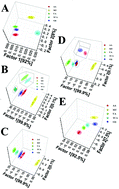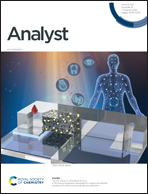Colorimetric discriminatory array for detection and discrimination of antioxidants based on HAuCl4/3,3′,5,5′-tetramethylbenzidine†
Abstract
Here, we report a simple but effective nose/tongue-mimic sensor array based on HAuCl4/3,3′,5,5′-tetramethylbenzidine (TMB) for colorimetric discrimination and determination of antioxidants. Two concentrations of HAuCl4 were employed as receptor units to construct the colorimetric sensor array. The sensing strategy is based on the fact that HAuCl4 with different concentrations (0.08 and 0.03 mM) could oxidize TMB to oxidized TMB (oxTMB), resulting in a blue and green color solution, respectively, corresponding to an absorption peak centered at 440 nm and 657 nm. However, the presence of different antioxidants could cause the reduction in HAuCl4, leading to the fading of the blue and green color and the decrease in the absorbance at 440 nm and 657 nm to varying degrees. Based on the above phenomena, by taking advantage of linear discriminant analysis (LDA), five antioxidants (i.e. ascorbic acid (AA), melatonin (MT), uric acid (UA), tannic acid (TCA), and glycine (Gly)) at five concentrations (200, 120, 60, 20, and 1 nM) were successfully discriminated both in buffer and serum. More importantly, this approach is simple, fast, and without the use of any nanomaterials.



 Please wait while we load your content...
Please wait while we load your content...